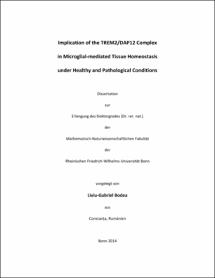Bodea, Liviu-Gabriel: Implication of the TREM2/DAP12 Complex in Microglial-mediated Tissue Homeostasis under Healthy and Pathological Conditions. - Bonn, 2014. - Dissertation, Rheinische Friedrich-Wilhelms-Universität Bonn.
Online-Ausgabe in bonndoc: https://nbn-resolving.org/urn:nbn:de:hbz:5n-35459
Online-Ausgabe in bonndoc: https://nbn-resolving.org/urn:nbn:de:hbz:5n-35459
@phdthesis{handle:20.500.11811/6063,
urn: https://nbn-resolving.org/urn:nbn:de:hbz:5n-35459,
author = {{Liviu-Gabriel Bodea}},
title = {Implication of the TREM2/DAP12 Complex in Microglial-mediated Tissue Homeostasis under Healthy and Pathological Conditions},
school = {Rheinische Friedrich-Wilhelms-Universität Bonn},
year = 2014,
month = mar,
note = {Microglial activation was previously associated with neurodegenerative diseases such as Parkinson’s disease (PD) or Alzheimer’s disease (AD). The prototype of primary microglia neurodegenerative disorder is represented by the Nasu-Hakola disease (NHD), which is caused by loss of function mutations in the microglial triggering receptor expressed in myeloid cells 2 (TREM2) or its associated adaptor molecule DNAX-activating protein of molecular mass 12 kDa (DAP12). Recently, mutations in TREM2 were associated with late onset AD (LOAD). The mechanisms of TREM2/DAP12-mediated neurodegeneration are still not fully understood.
Within this thesis, in vitro and/or in vivo models of NHD, PD and LOAD were investigated with an emphasis on the mechanisms of microglia-mediated neurodegeneration.
As model for NHD, TREM2 knock-out (KO) animals were found to develop an activated-like microglial phenotype when compared with appropriate wild type (WT) controls. However, only the old TREM2 KO animals present altered microglial-related gene expressions. Systemic lipopolysaccharide (LPS) stimulation of mice accentuated the differences in TREM2 KO microglial phenotype, but without inducing significant differences between microglia-related proinflammatory transcripts in TREM2 KO compared with control mice. LPS challenges were previously associated with dopaminergic loss, a neuropathological trait of PD. To investigate the mechanism of LPS-triggered dopaminergic degeneration, WT mice were challenged with LPS and transcriptome analysis of whole brains was performed. The analysis revealed enrichement in microglial phagosiome and complement-related genes. To prove the complement involvement in neuronal loss, C3 KO animals were challenged with LPS. Dopaminergic neuronal loss was found to be ameliorated in C3 KO mice. LOAD investigation using genome wide association studies revealed specific enrichment of the immune-related module, with DAP12 acting as causal regulator. Modified microglia cell lines overexpressing functional or non- functional DAP12 were generated and were able to recapitulate expression patterns specific to LOAD brains. Furthermore, microglial cells were able to take up amyloid and release neurotoxic superoxide only when expressing functional DAP12.
The present thesis proposes microglial-related mechanisms in which different immune-related pathways are converging, contributing to the neurodegenerative processes.},
url = {https://hdl.handle.net/20.500.11811/6063}
}
urn: https://nbn-resolving.org/urn:nbn:de:hbz:5n-35459,
author = {{Liviu-Gabriel Bodea}},
title = {Implication of the TREM2/DAP12 Complex in Microglial-mediated Tissue Homeostasis under Healthy and Pathological Conditions},
school = {Rheinische Friedrich-Wilhelms-Universität Bonn},
year = 2014,
month = mar,
note = {Microglial activation was previously associated with neurodegenerative diseases such as Parkinson’s disease (PD) or Alzheimer’s disease (AD). The prototype of primary microglia neurodegenerative disorder is represented by the Nasu-Hakola disease (NHD), which is caused by loss of function mutations in the microglial triggering receptor expressed in myeloid cells 2 (TREM2) or its associated adaptor molecule DNAX-activating protein of molecular mass 12 kDa (DAP12). Recently, mutations in TREM2 were associated with late onset AD (LOAD). The mechanisms of TREM2/DAP12-mediated neurodegeneration are still not fully understood.
Within this thesis, in vitro and/or in vivo models of NHD, PD and LOAD were investigated with an emphasis on the mechanisms of microglia-mediated neurodegeneration.
As model for NHD, TREM2 knock-out (KO) animals were found to develop an activated-like microglial phenotype when compared with appropriate wild type (WT) controls. However, only the old TREM2 KO animals present altered microglial-related gene expressions. Systemic lipopolysaccharide (LPS) stimulation of mice accentuated the differences in TREM2 KO microglial phenotype, but without inducing significant differences between microglia-related proinflammatory transcripts in TREM2 KO compared with control mice. LPS challenges were previously associated with dopaminergic loss, a neuropathological trait of PD. To investigate the mechanism of LPS-triggered dopaminergic degeneration, WT mice were challenged with LPS and transcriptome analysis of whole brains was performed. The analysis revealed enrichement in microglial phagosiome and complement-related genes. To prove the complement involvement in neuronal loss, C3 KO animals were challenged with LPS. Dopaminergic neuronal loss was found to be ameliorated in C3 KO mice. LOAD investigation using genome wide association studies revealed specific enrichment of the immune-related module, with DAP12 acting as causal regulator. Modified microglia cell lines overexpressing functional or non- functional DAP12 were generated and were able to recapitulate expression patterns specific to LOAD brains. Furthermore, microglial cells were able to take up amyloid and release neurotoxic superoxide only when expressing functional DAP12.
The present thesis proposes microglial-related mechanisms in which different immune-related pathways are converging, contributing to the neurodegenerative processes.},
url = {https://hdl.handle.net/20.500.11811/6063}
}






